Patna School of Painting
Patna School of Painting (also Patna Qalaam, Patna Kalam, or Company painting) is a style of Indian painting which existed in Bihar, India in the 18th and 19th centuries.[1] Patna Qalaam was the world’s first independent school of painting which dealt exclusively with the commoner and his lifestyle also helped Patna Kalam paintings gain in popularity.[2] The Principal centers were Patna, Danapur and Arrah.
Origin
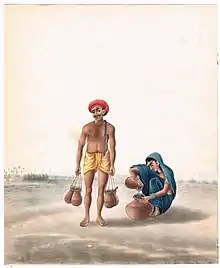
Patna Kalam is an off-shoot of Mughal painting. The Mughal style of painting matured in the regime of Jahangir, and his period was considered the golden era of Mughal paintings,[3] but during the rule of Aurangzeb in the late 17th and early 18th century, artisans faced mass prosecution and aversion in art and painting. The painters migrated from Delhi looking for shelter in different places. One such group moved eastward and landed in Murshidabad under the patronage of the Nawab of Bengal and other local aristocrats.
In the mid 18th century, after the fall of The Nawab of Bengal and subsequent decline of Murshidabad, the artisans started moving to the next biggest city in the east, Patna. In Patna they came under patronage of local aristocracy and often Indophile scions of the early East India and started a unique form of painting which came to be known as the Company painting, or Patna Kalam.[4][5]
Style
Patna Kalam is regarded as an off-shoot of Mughal painting, with influences from Persian and Company (British) styles.[6] The portraits can be clearly seen having colours and linings from Mughal style, and the shading can be seen to be adopted from the British style.[7] Diverging from the Mughal and Persian style of wide and exquisitely decorated borders, Patna Kalam primarily focused on the subject of the painting.
Unlike Mughal painting, which focused on the royalty and court scenes, flag bearers of Patna Kalam were deeply influenced by daily life of common man. Their main subjects were local festivals, ceremonies, bazaar scenes, local rulers, and domestic activities. The paintings were done on diverse surfaces such as paper, mica, and even ivory diskettes, that were used as brooches.[4]
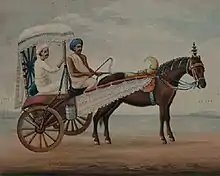
A distinguishing characteristic of Patna Kalam is lack of any landscape, foreground or background. Another characteristic was the development in the shading of solid forms. Patna Kalam paintings are painted straightway with the brush without marking with pencil to delineate the contours of the picture and the procedure of painting is popularly known as 'Kajli Seahi.'[5]
Patna Kalam Today
Some well known painters of Patna Kalam were Sewak Ram, Hulas Lall, Shiv Lal, Shiva Dayal, Mahadeo Lal, and Ishwari Prasad Verma. There is currently no one to carry on the tradition. Only three collections of Patna Kalam paintings exist in Bihar, one at the Patna Museum and others at Khuda Baksh library, Patna, and Patna University’s College of Arts and Crafts. The Patna Kalam flourished only as long as its Western patrons existed.
Gallery
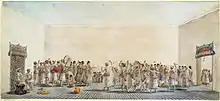 Holi being played in the courtyard, ca 1795 painting in Patna style.
Holi being played in the courtyard, ca 1795 painting in Patna style..JPG.webp) Gol Ghar, 19th Century Painting
Gol Ghar, 19th Century Painting Durga Puja, 1809 watercolour painting in Patna Style
Durga Puja, 1809 watercolour painting in Patna Style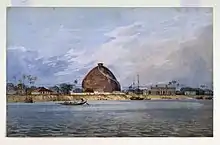 GolGhar, 19th Century Painting
GolGhar, 19th Century Painting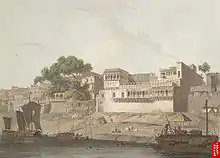 Patna along The Ganges
Patna along The Ganges Snake charmer, 19th century
Snake charmer, 19th century
References
| Wikimedia Commons has media related to Patna School paintings. |
- "Bihar Culture". Archived from the original on 17 June 2011. Retrieved 19 October 2008.
- "Patna Kalam comes alive in 30-minute documentary". www.telegraphindia.com. Archived from the original on 25 December 2018. Retrieved 25 December 2018.
- "Patna Kalam Paintings an Introduction". Archived from the original on 15 May 2019.
- "Return of the 'Patna Kalam'". Archived from the original on 15 May 2019.
- "Patna Kalam Painting- Origin and Characteristics". Archived from the original on 25 April 2019.
- "Patna Kalam - Patna School of Painting Bihar India". www.bharatonline.com. Archived from the original on 25 December 2018. Retrieved 25 December 2018.
- Rajya Sabha TV, RSTV Documentary - Patna Kalam, retrieved 25 December 2018
Further reading
- Kossak , Steven (1997). Indian court painting, 16th-19th century.. New York: The Metropolitan Museum of Art. ISBN 0870997831. (see index: p. 148-152)